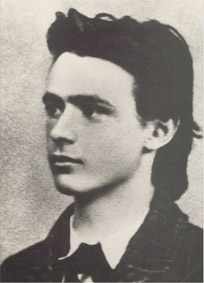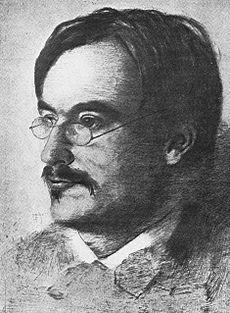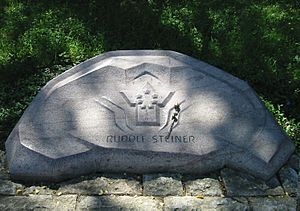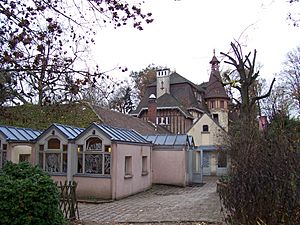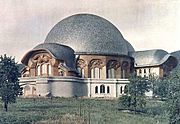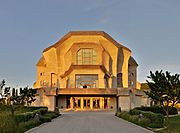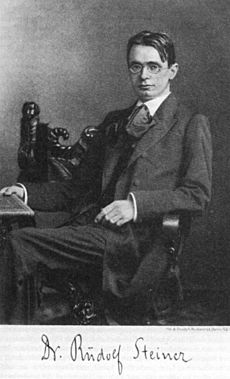Rudolf Steiner facts for kids
Quick facts for kids
Rudolf Steiner
|
|
|---|---|
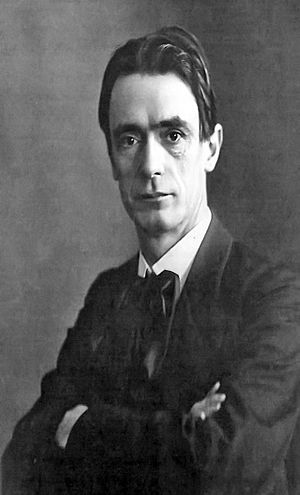
Steiner c. 1905
|
|
| Born |
Rudolf Joseph Lorenz Steiner
27 February 1861 Murakirály, Kingdom of Hungary, Austrian Empire (now Donji Kraljevec, Croatia)
|
| Died | 30 March 1925 (aged 64) Dornach, Switzerland
|
| Education | Vienna Institute of Technology University of Rostock (PhD, 1891) |
| Spouse(s) |
Anna Eunicke
(m. 1899; died 1911)Marie Steiner-von Sivers
(m. 1914) |
| Part of a series on |
| Anthroposophy |
|---|
| General |
|
| Anthroposophically inspired work |
|
| Philosophy |
|
Rudolf Joseph Lorenz Steiner (born February 27, 1861 – died March 30, 1925) was an Austrian thinker. He was known for his ideas on spirituality, social change, and architecture. Steiner first became known in the late 1800s as a writer and literary critic. He wrote books like The Philosophy of Freedom.
In the early 1900s, he started a spiritual movement called anthroposophy. This movement combined ideas from German philosophy and theosophy. Steiner wanted to connect science with spirituality. He called his approach "spiritual science". He believed clear thinking could help understand spiritual questions.
Later, Steiner explored different art forms like drama, dance, and architecture. This led to the creation of the Goetheanum. It was a cultural center designed to bring all arts together. After World War I, Steiner started many practical projects. These included Waldorf education, biodynamic agriculture, and anthroposophical medicine.
Steiner believed in ethical individualism. This means each person should develop their own moral values. He thought that thinking is like an organ, just like eyes or ears. He believed thinking helps us understand ideas. A key idea in his work was that there are no limits to what humans can learn.
Contents
Rudolf Steiner's Life Story
Early Years and School
Rudolf Steiner's father, Johann Steiner, was a telegraph operator. He worked for the Southern Austrian Railway. Rudolf was born in Murakirály, which is now Donji Kraljevec in Croatia. When Rudolf was very young, his family moved a few times. They settled in Pottschach, in the Austrian Alps.
Steiner went to the village school. After a disagreement, he was taught at home for a short time. In 1869, his family moved to Neudörfl. In 1872, Steiner went to a better school in Wiener Neustadt.
In 1879, his family moved to Inzersdorf near Vienna. This allowed Steiner to attend the Vienna Institute of Technology. He studied many subjects there, including mathematics, physics, and chemistry. He also learned about literature and philosophy. He received a scholarship from 1879 to 1883.
In 1882, one of his teachers, Karl Julius Schröer, suggested Steiner to Joseph Kürschner. Kürschner was editing a new collection of Goethe's works. He asked Steiner to be the science editor. This was a big chance for a young student.
Spiritual Discoveries
When Steiner was nine, he believed he saw the spirit of his aunt. She had died far away, and his family did not yet know about it. Steiner later said he felt that understanding the spiritual world was like understanding geometry. He felt that his mind could experience things on its own. This feeling helped him believe in a world that is not seen.
Steiner believed that by age 15, he understood the idea of time completely. He thought this was important for developing clairvoyance. At 21, he met a man on a train who spoke about the spiritual world. This man seemed to have his own experiences there.
Writer and Thinker
In 1888, Steiner was invited to work at the Goethe archives in Weimar. He stayed there until 1896. He wrote introductions and comments for Goethe's scientific writings. He also wrote two books about Goethe's philosophy. These included The Theory of Knowledge Implicit in Goethe's World-Conception (1886). Steiner saw this book as the base for all his later work.
In 1891, Steiner earned his PhD in philosophy from the University of Rostock. His paper was about Johann Gottlieb Fichte's idea of the "ego." Two years later, in 1894, he published The Philosophy of Freedom. This book explored how humans can become spiritually free. Steiner later said this book contained all the ideas he would later develop in anthroposophy.
In 1896, Steiner turned down an offer to help with the Nietzsche archive. He then moved to Berlin in 1897. He became an editor for a literary magazine. He hoped to share his philosophy there. However, his support for Émile Zola in the Dreyfus Affair caused some readers to leave. He also published letters from an anarchist, which led to more problems. He eventually left the magazine. In 1899, Steiner married Anna Eunicke. They separated several years later, and Anna died in 1911.
Theosophical Society and New Beginnings
In 1899, Steiner wrote an article about the hidden meaning in Goethe's fairy tale The Green Snake and the Beautiful Lily. This led to an invitation to speak to a group of Theosophists. Steiner continued to speak to members of the Theosophical Society. In 1902, he became the head of its new German section. He never officially joined the society. Through this group, Steiner met Marie von Sivers, who became his second wife in 1914.
Steiner wanted to create a spiritual path based on European traditions. The German section of the Theosophical Society grew quickly under his leadership. He lectured across Europe about his "spiritual science". He used his own terms and ideas, different from other Theosophists. He also disagreed with claims that Jiddu Krishnamurti was a new world teacher. These differences led to a split in 1912–1913. Steiner and most German members left to form the Anthroposophical Society. He named it "Anthroposophy" after an Austrian philosopher's work.
Anthroposophical Society and Its Projects
The Anthroposophical Society grew quickly. They needed a place for their yearly meetings and plays. So, they decided to build a theater and center. In 1913, construction began on the first Goetheanum in Dornach, Switzerland. Steiner designed the building, and many volunteers helped build it. Steiner moved to Dornach in 1913 and lived there for the rest of his life.
After World War I, Steiner gave many more lectures. From 1919 onwards, he worked with society members to start many practical projects. The first Waldorf school opened in Stuttgart, Germany, that year. On New Year's Eve 1922–1923, the Goetheanum burned down. Police thought it was arson. Steiner immediately began designing a second Goetheanum, this time made of concrete. It was finished in 1928, after his death.
In 1923, Steiner founded the School of Spiritual Science. This school had sections for education, medicine, arts, sciences, and agriculture. It included meditative exercises from Steiner.
Challenges and Later Life
Steiner became a well-known figure during and after World War I. He suggested big social changes for Germany. He proposed a Threefold Social Order. This idea suggested that culture, politics, and economy should work separately but together. He believed mixing them caused problems like World War I.
The Nazi Party grew strong in Germany. In 1919, a Nazi theorist attacked Steiner. In 1921, Adolf Hitler also attacked Steiner. Other extremists called for a "war against Steiner." Steiner warned about the dangers if the Nazis came to power. In 1922, a lecture by Steiner in Munich was interrupted. People tried to attack him, but he escaped. His future lectures were canceled for safety reasons. After the 1923 Beer Hall Putsch, Steiner left Berlin. He said he couldn't return if the Nazis took power.
From 1923, Steiner became more ill. But he kept lecturing and traveling. He often gave several lectures a day. Many of these focused on practical areas like education.
He gave his last lecture in September 1924. He continued working on his autobiography. Rudolf Steiner died in Dornach on March 30, 1925.
After his death, Nazi leaders like Adolf Hitler attacked Steiner in the press. They said his ideas were against Nazi beliefs. They also falsely claimed he was Jewish. However, some high-ranking Nazis, like Rudolf Hess, supported Anthroposophy and Waldorf schools. This meant that Anthroposophists were not as badly treated by the Nazi regime as other groups.
Spiritual Research
Steiner began speaking publicly about spiritual experiences in 1899. From 1900, he lectured about details of the spiritual world. In 1904, he published Theosophy: An Introduction to the Spiritual Processes in Human Life and in the Cosmos. He wanted to apply his training in mathematics and philosophy to spiritual experiences.
He believed that with meditative training, anyone could experience the spiritual world. This training, he thought, would help people become more moral, creative, and free. Steiner's ideas were influenced by philosophers like Fichte, Hegel, and Goethe.
Steiner used the term Geisteswissenschaft, or "spiritual science." He meant a systematic way to study the spirit. He believed humans could understand things beyond what their senses show. He thought that psychology and humanities were based on understanding an ideal reality.
Steiner also believed that understanding reincarnation and karma was important for psychology. He said that a person is not stuck by their karma. They can change their future by actively taking control of their own nature. From 1910, he described how karma relates to health and free will. In 1924, he gave lectures on how he researched karma.
Steiner's Many Activities
After World War I, Steiner became involved in many different areas. He started schools, the first being the Waldorf school. This grew into a worldwide network. He also began a system of farming called biodynamic agriculture. This was one of the first types of modern organic farming. His ideas in medicine led to new therapies and medications. Many homes for children and adults with developmental disabilities are also based on his work.
Steiner's writings are extensive. He wrote books, essays, and four plays. He also gave over 6,000 lectures. His drawings, often made during his lectures, are also collected. His architectural designs are seen as important examples of modern architecture.
Education
As a young man, Steiner was a private tutor. He also lectured on history for working-class adults in Berlin. He began to share his ideas on education in public lectures. In 1907, he wrote an essay called The Education of the Child. In it, he described the main stages of child development. This formed the basis of his educational approach.
In 1919, Emil Molt invited Steiner to lecture to his workers at a cigarette factory. These lectures led to the first Waldorf School in Stuttgart. Steiner's ideas spread, and today there are over 1,000 Waldorf schools worldwide.
Biodynamic Agriculture
In 1924, farmers asked Steiner for help with agriculture. He gave a series of lectures on an ecological and sustainable way to farm. This method aimed to improve soil without using chemical fertilizers or pesticides. Steiner's ideas quickly spread around the world.
A main idea of biodynamics is that the farm is like one living organism. It should largely support itself, producing its own manure and animal feed. Plant or animal sickness is seen as a sign of problems in the whole farm. Steiner also suggested timing farm activities like planting and harvesting. He believed this could use the influences of the moon and planets on plant growth. He encouraged farmers to test these ideas themselves.
Some experts, like Peter Treue, have called biodynamics a pseudoscience. They say similar results can be achieved with standard organic farming. He also said some biodynamic methods seem like alchemy or magic.
Anthroposophical Medicine
From the late 1910s, Steiner worked with doctors to create a new approach to medicine. In 1921, pharmacists and doctors started a company called Weleda. It now sells natural medical and beauty products worldwide. Around the same time, Dr. Ita Wegman opened the first anthroposophic medical clinic in Arlesheim. Anthroposophic medicine is practiced in about 80 countries. It is a form of alternative medicine based on pseudoscientific and occult ideas.
Social Ideas
After World War I, Steiner lectured on social reform. He suggested that society's cultural, political, and economic parts should work together. But they should also be independent. Political groups should be democratic and protect human rights. Cultural groups should support science, art, education, and religion. Economic groups should help people work together to meet society's needs. He believed this division of tasks was important for society.
Architecture and Art
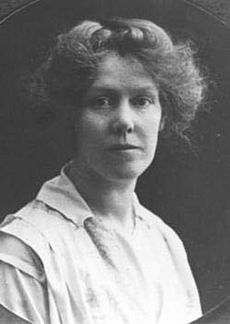
Steiner designed 17 buildings. These included the First and Second Goetheanums in Dornach, Switzerland. These buildings were meant for theater and a "school for spiritual science." Three of Steiner's buildings are considered important examples of modern architecture.
His main sculpture is The Representative of Humanity (1922). It is a nine-meter-high wooden sculpture. He created it with sculptor Edith Maryon. It shows a human figure balancing opposing forces. This sculpture is now on display at the Goetheanum.
Steiner's blackboard drawings were unique. They were not originally meant as art. But artist Joseph Beuys, who was influenced by Steiner, helped people see them as art.
Performing Arts
Steiner wrote four mystery plays between 1909 and 1913. These included The Portal of Initiation. His plays are still performed by anthroposophical groups today.
With Marie von Sivers, Steiner also created a new way of acting and storytelling. His last public lectures in 1924 were about speech and drama. The Russian actor Michael Chekhov based parts of his acting method on Steiner's work.
Rudolf Steiner and Marie von Sivers also developed eurythmy. This art form is sometimes called "visible speech and song." It involves movements and gestures that match sounds, rhythms, and feelings in speech and music.
Esoteric Schools
Steiner founded and led several esoteric schools:
- His independent Esoteric School of the Theosophical Society, started in 1904. It continued after the split with Theosophy.
- A lodge called Mystica Aeterna within a Masonic Order. Steiner led this from 1906 to about 1914.
- The School of Spiritual Science of the Anthroposophical Society. This was founded in 1923. It had sections for education, medicine, and arts. Steiner gave members exercises for spiritual development.
Steiner's Philosophical Ideas
Goethean Science
Steiner wrote about Goethe's scientific work from 1884 to 1897. He saw Goethe's approach to science as focusing on direct observation, not just theories. He developed this idea in books like The Theory of Knowledge Implicit in Goethe's World-Conception (1886). He highlighted how Goethe used observation and imagination to find patterns in nature.
Steiner believed Goethe had tried to understand the animal kingdom in a similar way. He noted Goethe's discovery of a bone in humans, showing how human anatomy evolved from animals. Steiner also defended Goethe's ideas about color. Goethe believed colors came from light and darkness, unlike Newton's particle theory.
Some authors have called Goethean science a pseudoscience. For example, it has been said that Steiner believed:
- Goethe's Theory of Colours was correct.
- Relativity was "brilliant nonsense."
- The motions of the planets were caused by spiritual beings.
- The heart is not a pump.
Knowledge and Freedom
Steiner explored the ideas of knowledge and freedom. In his paper Truth and Knowledge (1892), he disagreed with Kant's idea that some truth is beyond human understanding. Steiner believed the world is one whole. Our minds divide it into what we sense and what we think.
He thought that thinking can be trained to understand what our senses don't show. So, the spiritual and natural worlds are not separate. They are two views of the same world. For Steiner, Truth is something we discover and also something we create. Understanding means creating a new area of knowledge. This new area, with our senses, makes up all of reality.
In The Philosophy of Freedom, Steiner looked deeper into thinking. He suggested that freedom can only be reached through creative thinking. Thinking can be a free act. It can also free our will from our instincts. Free actions are those where we fully understand why we are acting. Freedom means understanding ourselves and the world with full awareness. It also means overcoming influences from our family or environment. "To be free is to be capable of thinking one's own thoughts," he wrote.
Steiner agreed with Darwin's and Haeckel's ideas of evolution. But he extended them beyond just physical things. He saw human consciousness and culture as products of natural evolution that go beyond it. For Steiner, nature becomes aware of itself through humans.
Spiritual Science
In his early writings, Steiner spoke of the "natural and spiritual worlds" as one. From 1900, he lectured about the spiritual world. In 1904, he published Theosophy: An Introduction to the Spiritual Processes in Human Life and in the Cosmos. He wanted to apply scientific methods to spiritual topics.
From 1903 to 1908, Steiner published essays on topics like reincarnation and knowledge of the supernatural world. Some of these became books like How to Know Higher Worlds (1904–5). He published An Outline of Esoteric Science in 1910. Key ideas included:
- Humans as body, soul, and spirit.
- The path of spiritual development.
- Spiritual influences on world history.
- Reincarnation and karma.
Steiner believed there is an objective spiritual world that can be known. He thought that with proper training, like in natural sciences, people could experience the spiritual world. He called this "spiritual science". He believed natural science was good but only focused on what we can sense. Mysticism, he thought, was vague. Anthroposophy aimed to combine the systematic methods of science with the content of spiritual life.
For Steiner, the universe is filled with creative spiritual activity. To understand this, humans must recreate this activity within themselves. So, spiritual knowledge involves creative inner work. Steiner described three steps for any creative act:
- Moral intuition: Finding good ethical principles.
- Moral imagination: Turning these principles into a plan for a specific situation.
- Moral technique: Making the plan happen, using practical skills.
Steiner called his work from this time Anthroposophy. He stressed that his spiritual path supports individual freedom and independent judgment. He believed spiritual training helps human evolution. It helps develop love and freedom.
Steiner and Christianity
Steiner had a deep respect for the church rituals he experienced as a child. He felt it was a truly spiritual experience. As a young man, he was not part of any organized religion. In 1899, he had a powerful inner experience with the being of Christ. This happened after a great inner struggle. He felt he stood "in the spiritual presence of the Mystery of Golgotha." His connection to Christianity after this was based on his own experience. It was not tied to any specific church.
Christ and Human Evolution
Steiner saw Christ as central to Earth's evolution and human history. He believed Christ redeems the Fall from Paradise. He understood Christ as a being that unites all religions. Christ does not belong to just one faith. For Steiner, being "Christian" meant finding balance and showing love freely.
His main ideas included:
- The Christ being is central to all religions, even if called by different names.
- Every religion is true for its time and culture.
- Traditional Christianity needs to change to fit human evolution.
In Steiner's view, human spiritual development is linked to the universe's development. Christ brings an impulse that helps humans understand the creative forces in nature.
Differences from Traditional Christian Beliefs
Steiner's views on Christianity were different from traditional ones. They included gnostic ideas. However, Steiner believed in the real physical coming of Christ in Jesus.
One main difference was Steiner's ideas on reincarnation and karma.
Steiner also believed there were two different Jesus children involved in Christ's coming. One child came from Solomon's line, as in the Gospel of Matthew. The other came from Nathan's line, as in the Gospel of Luke. He noted that the family trees in these two gospels are very different from David to Jesus.
Steiner's view of the second coming of Christ was also unique. He thought it would not be a physical return. Instead, the Christ being would appear in a non-physical form. This would be in the "etheric realm." It would be visible to spiritual sight and in community life. He believed this would start around 1933. He warned that people might use the name "Christ" but ignore the true meaning of this Being of Love.
The Christian Community
In the 1920s, a Lutheran pastor named Friedrich Rittelmeyer asked Steiner for help. He wanted to create a more modern form of Christianity. Other pastors and theology students joined him. Steiner advised them on how to renew the power of the sacraments. He also stressed freedom of thought and a personal connection to religion. He imagined a new blend of Catholic and Protestant ideas. He called it "modern, Johannine Christianity."
This movement became known as "The Christian Community". It focuses on a free relationship with Christ, without strict rules. Its priests, both men and women, can preach based on their own spiritual insights.
Steiner said this movement was his personal help to Rittelmeyer and others. He saw it as separate from his anthroposophical work. This was important to Steiner. He wanted Anthroposophy to be a scientific spirituality, not based on faith. But he knew that for those who wanted traditional forms, renewing religions was also important.
Rudolf Steiner's Writings
Steiner's collected works fill about 422 volumes. This includes 44 volumes of his books, essays, plays, and letters. It also has over 6,000 lectures. About 80 volumes document his artistic work. His architectural work has also been widely documented.
- Goethean Science (1883–1897)
- Theory of Knowledge Implicit in Goethe's World-Conception (1886)
- Truth and Knowledge, doctoral paper, (1892)
- Intuitive Thinking as a Spiritual Path, also called The Philosophy of Spiritual Activity and The Philosophy of Freedom (1894) ISBN: 0-88010-385-X
- Mysticism at the Dawn of Modern Age (1901/1925)
- Christianity as Mystical Fact (1902)
- Theosophy: An Introduction to the Spiritual Processes in Human Life and in the Cosmos (1904) ISBN: 0-88010-373-6
- How to Know Higher Worlds: A Modern Path of Initiation (1904–5) ISBN: 0-88010-508-9
- Cosmic Memory: Prehistory of Earth and Man (1904) (Also published as The Submerged Continents of Atlantis and Lemuria)
- The Education of the Child, (1907) ISBN: 0-85440-620-4
- The Way of Initiation, (1908)
- Initiation and Its Results, (1909)
- An Outline of Esoteric Science (1910) ISBN: 0-88010-409-0
- Four Mystery Dramas (1913)
- The Renewal of the Social Organism (1919)
- Fundamentals of Therapy: An Extension of the Art of Healing Through Spiritual Knowledge (1925)
- Reincarnation and Immortality, Rudolf Steiner Publications. (1970)
- Rudolf Steiner: An Autobiography, Rudolf Steiner Publications, 1977, ISBN: 0-8334-0757-0 (Originally, The Story of my Life)
- Rudolf Steiner, Friedrich Nietzsche, Fighter for Freedom Garber Communications; 2nd revised edition (July 1985) ISBN: 978-0893450335
Images for kids
See also
 In Spanish: Rudolf Steiner para niños
In Spanish: Rudolf Steiner para niños
- Esotericism
- Guardian of the Threshold
- Rudolf Steiner and colour mysticism
- Martinus



